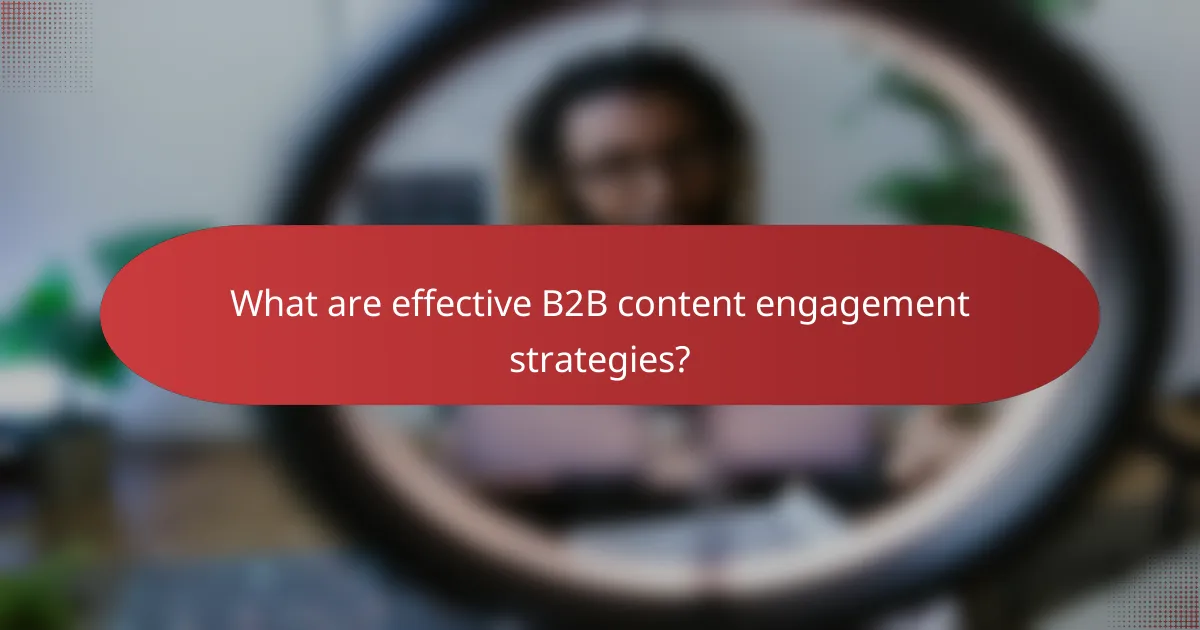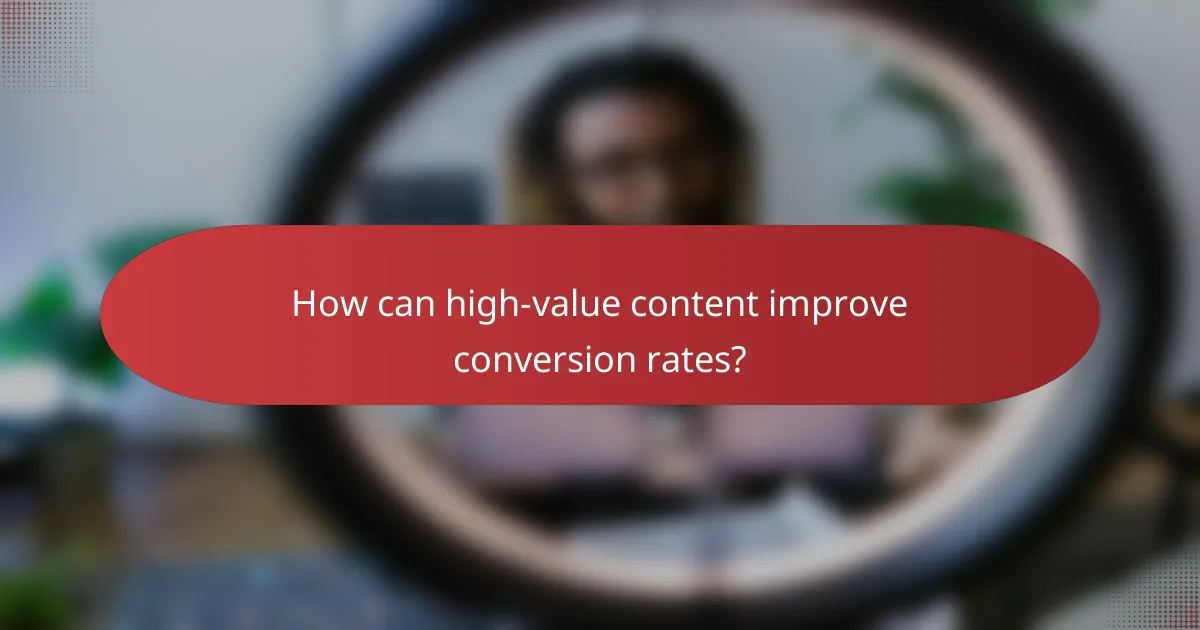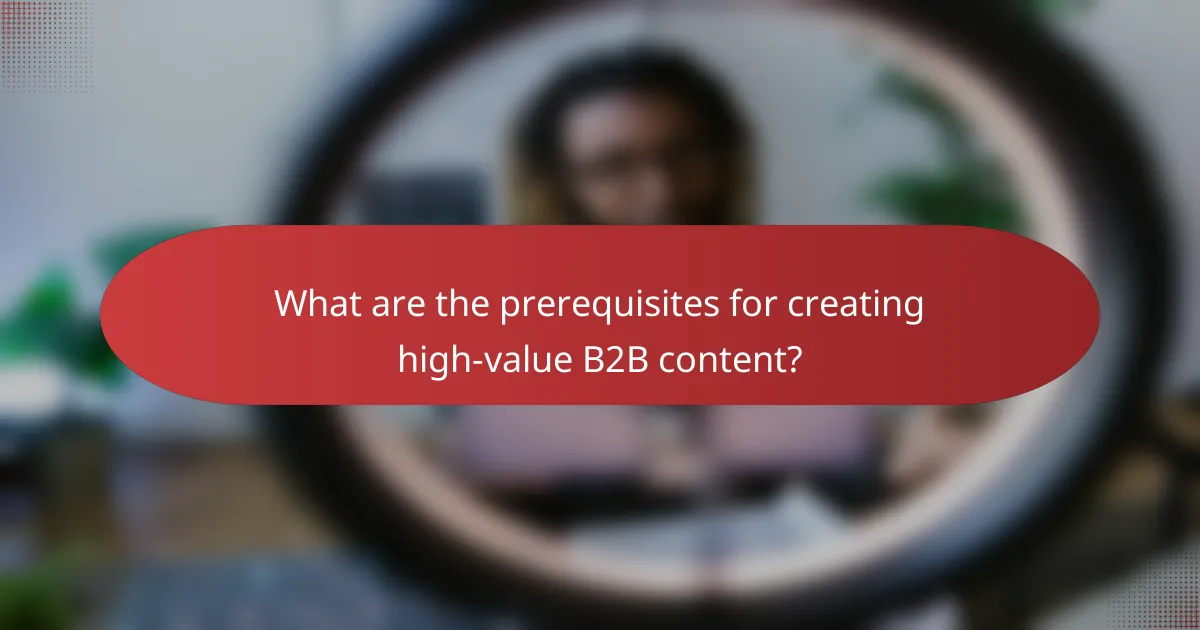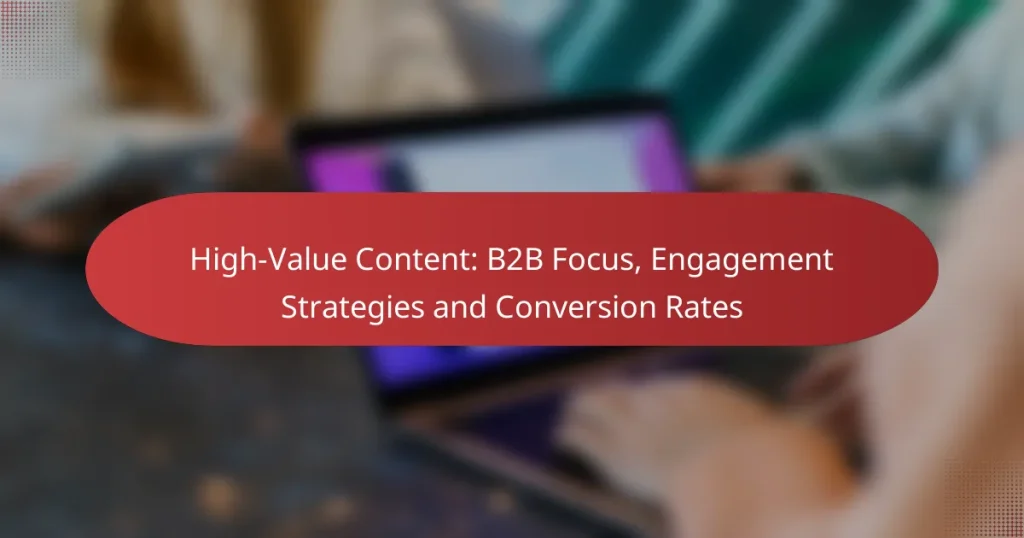In the competitive landscape of B2B marketing, high-value content is essential for driving engagement and boosting conversion rates. By focusing on personalized and interactive experiences, businesses can create meaningful connections with their target audiences, fostering trust and loyalty. Effective content strategies not only provide relevant information but also utilize key metrics to measure success and refine approaches for optimal results.

What are effective B2B content engagement strategies?
Effective B2B content engagement strategies focus on creating personalized, interactive, and valuable experiences that resonate with target audiences. These strategies aim to foster deeper connections, enhance brand loyalty, and ultimately drive higher conversion rates.
Personalized email campaigns
Personalized email campaigns are tailored messages that address the specific needs and interests of individual recipients. By segmenting your audience based on factors like industry, behavior, or previous interactions, you can craft emails that feel relevant and engaging.
To maximize effectiveness, consider using dynamic content that changes based on recipient data. A/B testing subject lines and send times can also help optimize open and click-through rates, leading to better engagement outcomes.
Interactive content formats
Interactive content formats, such as quizzes, polls, and calculators, encourage active participation from users, making the experience more engaging. This type of content not only captures attention but also provides valuable insights into user preferences and behaviors.
Incorporating interactive elements can increase dwell time on your site and improve lead generation. For instance, a calculator that estimates ROI based on user inputs can effectively demonstrate value and prompt further inquiry.
Webinars and live events
Webinars and live events offer opportunities for real-time interaction and knowledge sharing. These formats allow businesses to showcase expertise, answer questions, and engage directly with potential clients.
To enhance participation, promote your events through multiple channels and consider offering incentives, such as exclusive resources or discounts for attendees. Follow up with participants afterward to nurture leads and maintain engagement.
Case studies and testimonials
Case studies and testimonials provide social proof that can significantly influence B2B purchasing decisions. By showcasing real-world examples of how your product or service has benefited other businesses, you build credibility and trust.
Include specific metrics and results in your case studies to demonstrate tangible outcomes. Highlighting diverse industries and challenges can also appeal to a broader audience, making your content more relatable.
Social media engagement
Social media engagement involves actively interacting with your audience on platforms where they spend time. This can include sharing valuable content, responding to comments, and participating in relevant discussions to foster community and brand loyalty.
Utilize analytics tools to track engagement metrics and adjust your strategy accordingly. Regularly posting industry insights, company updates, and user-generated content can keep your audience engaged and encourage sharing, expanding your reach.

How can high-value content improve conversion rates?
High-value content enhances conversion rates by providing relevant information that meets the needs of potential customers. This type of content builds trust, encourages engagement, and ultimately guides users through the purchasing process.
Targeted content marketing
Targeted content marketing focuses on creating content that speaks directly to specific segments of your audience. By understanding the unique challenges and interests of different buyer personas, you can tailor your messaging to resonate more effectively. This approach increases the likelihood of engagement and conversion.
For example, a software company might create case studies that address the needs of various industries, showcasing how their product solves specific problems. This targeted approach can lead to higher conversion rates as prospects see the relevance of the content to their own situations.
Clear calls-to-action
Clear calls-to-action (CTAs) are essential for guiding users toward the next steps in their journey. Effective CTAs should be concise, action-oriented, and visually distinct, making it easy for users to understand what they should do next. This clarity helps reduce friction and encourages conversions.
For instance, instead of a vague “Learn More,” a more effective CTA might be “Download Your Free Guide Now.” This specificity not only clarifies the action but also adds value, increasing the chances of user engagement.
SEO optimization
SEO optimization is crucial for ensuring that high-value content is discoverable by your target audience. By incorporating relevant keywords, optimizing meta tags, and improving site speed, you can enhance your content’s visibility in search engine results. This increased visibility can lead to higher traffic and, consequently, more conversions.
Consider using tools like Google Analytics to track which keywords drive traffic to your site. Regularly updating your content to reflect current trends and search behaviors can also help maintain your rankings and attract more qualified leads.
Lead nurturing strategies
Lead nurturing strategies involve building relationships with potential customers through targeted communication over time. This can include personalized email campaigns, informative webinars, or tailored content that addresses their specific needs and interests. Effective nurturing keeps your brand top-of-mind and guides leads toward making a purchase decision.
For example, a B2B company might segment its email list based on engagement levels and send tailored content that aligns with each segment’s interests. This personalized approach can significantly improve conversion rates by ensuring that leads receive relevant information at the right time.

What metrics measure content engagement success?
Content engagement success is primarily measured through metrics that reflect how users interact with your content. Key metrics include click-through rates, time on page, lead generation rates, and social shares and interactions, each providing insights into audience interest and effectiveness of content strategies.
Click-through rates
Click-through rates (CTR) indicate the percentage of users who click on a link compared to the total number of users who view the content. A higher CTR suggests that your content is compelling and encourages action. Aim for CTRs in the range of 2-5% for B2B content, but this can vary based on industry and content type.
To improve CTR, use clear calls-to-action (CTAs) and ensure your headlines are engaging. Avoid vague language and focus on the benefits of clicking through to the next step.
Time on page
Time on page measures how long visitors stay on a specific piece of content. Longer times generally indicate that users find the content valuable and engaging. Aim for an average time on page of at least 2-3 minutes for articles, but this can vary based on content complexity and audience expectations.
To increase time on page, structure your content with subheadings, bullet points, and visuals to make it easier to digest. Consider incorporating interactive elements like quizzes or videos to keep users engaged longer.
Lead generation rates
Lead generation rates track how effectively your content converts visitors into leads. This metric is crucial for B2B businesses, as it directly impacts sales opportunities. A good lead generation rate can range from 1-5%, depending on the industry and the quality of the content offered.
To enhance lead generation, offer valuable resources like whitepapers or webinars in exchange for contact information. Ensure your landing pages are optimized for conversions with clear messaging and minimal distractions.
Social shares and interactions
Social shares and interactions measure how often your content is shared or engaged with on social media platforms. High levels of sharing indicate that your content resonates with your audience and has the potential to reach a wider audience. Aim for a steady increase in shares over time, as this reflects growing interest and engagement.
To boost social shares, create shareable content that includes eye-catching visuals and compelling headlines. Encourage sharing by adding social media buttons and prompting users to share their thoughts in the comments.

What are the prerequisites for creating high-value B2B content?
Creating high-value B2B content requires a deep understanding of your target audience, a thorough competitive analysis, and a well-defined content strategy. These elements ensure that your content resonates with your audience and stands out in a crowded marketplace.
Understanding target audience
To create effective B2B content, you must first identify and understand your target audience. This involves researching their pain points, preferences, and buying behaviors. Utilize surveys, interviews, and analytics to gather insights that inform your content creation.
Segment your audience based on criteria such as industry, company size, and role within the organization. Tailoring content to these segments increases relevance and engagement, leading to higher conversion rates.
Competitive analysis
Conducting a competitive analysis helps you identify what your competitors are doing well and where there are gaps in their content. Analyze their content types, topics, and engagement levels to uncover opportunities for differentiation.
Use tools like SEMrush or Ahrefs to assess competitors’ keyword strategies and backlink profiles. This information can guide your content creation to ensure you address topics that are underrepresented in your niche.
Content strategy development
A solid content strategy outlines your goals, target audience, and the types of content you will produce. Start by defining your objectives, such as increasing brand awareness or generating leads, and align your content accordingly.
Consider creating a content calendar to plan and schedule your posts. This helps maintain consistency and ensures a steady flow of high-value content. Regularly review and adjust your strategy based on performance metrics to optimize engagement and conversion rates.
